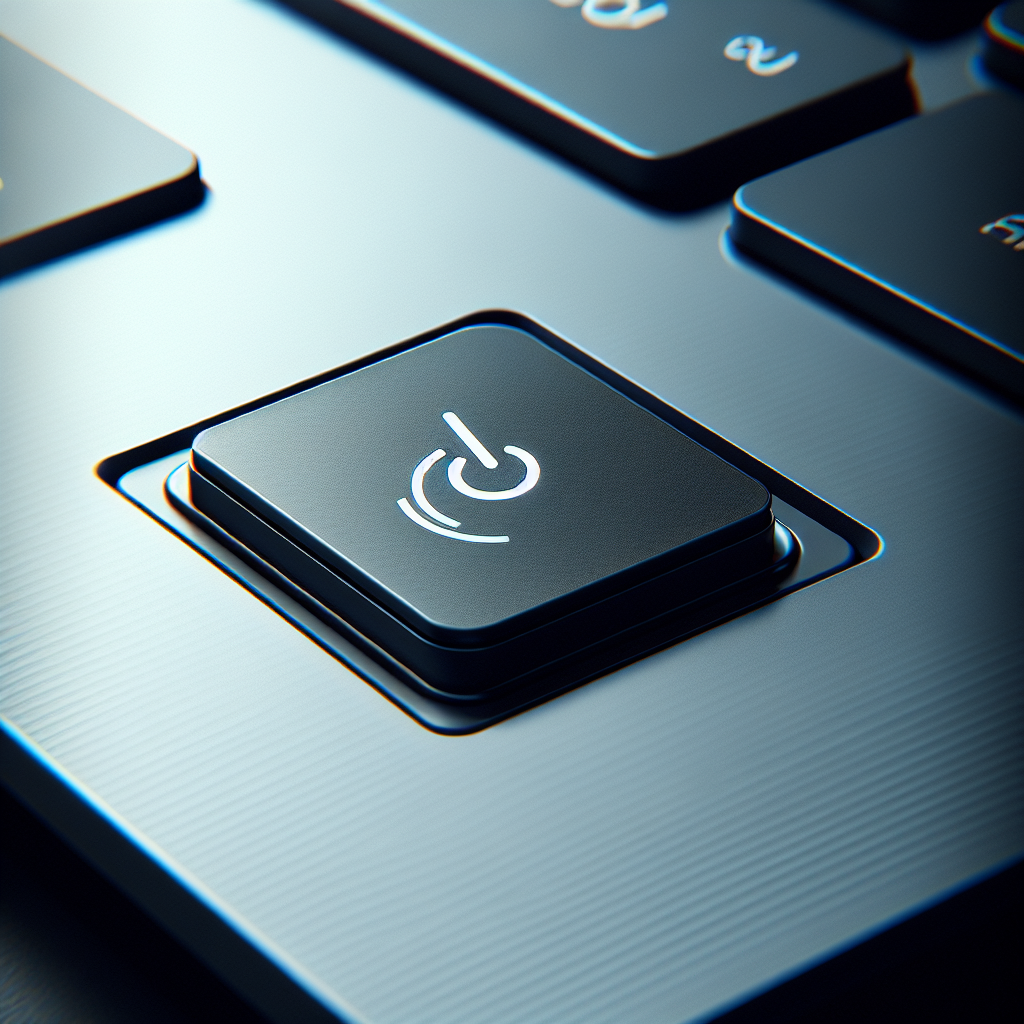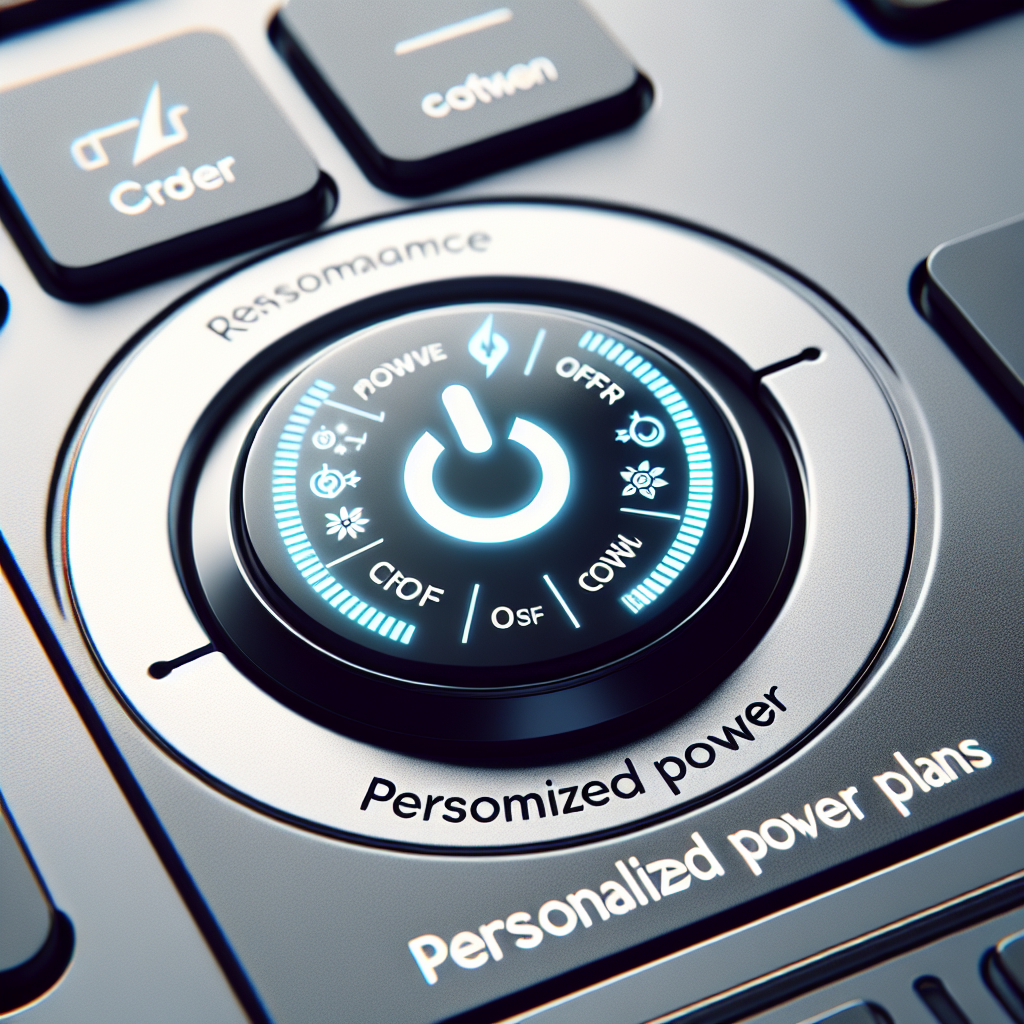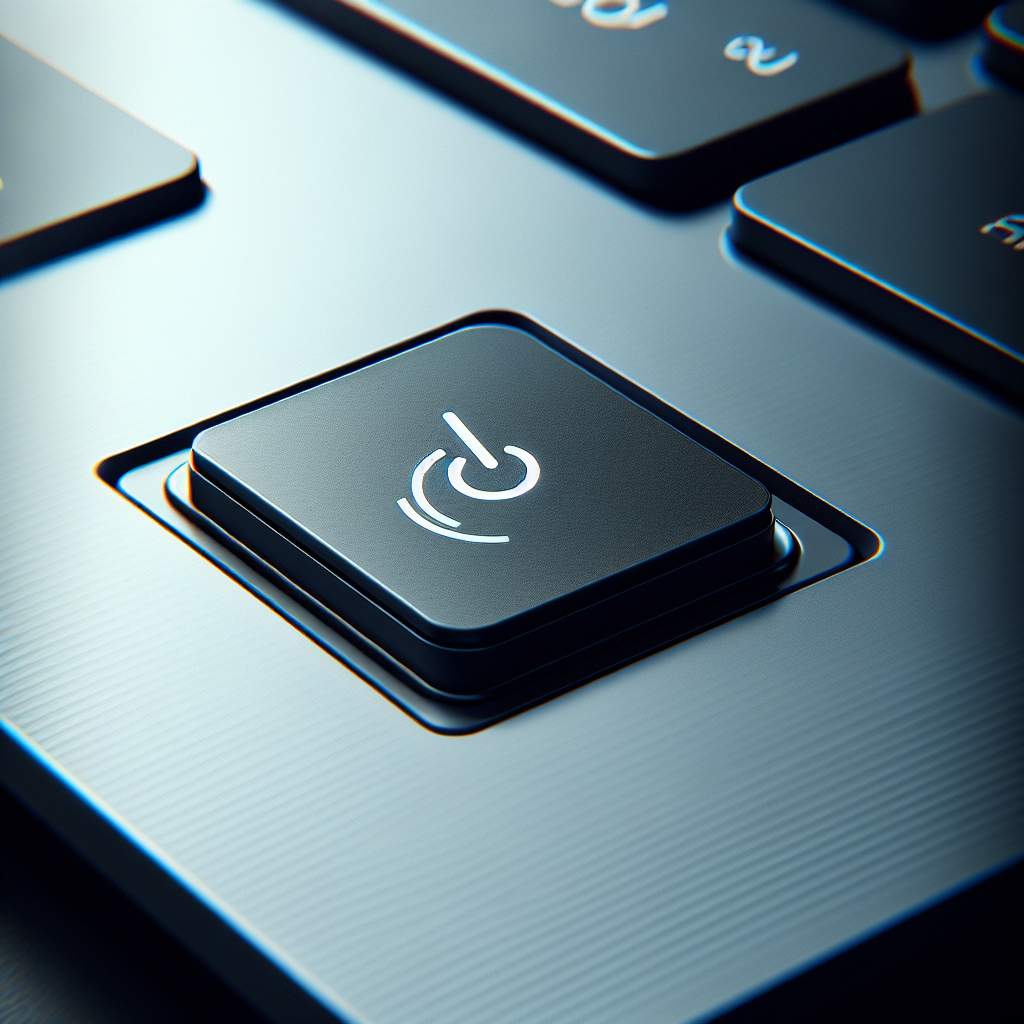Alright, so you just got yourself a brand new laptop and you can’t wait to start using it. But before you dive into all the fun stuff, there’s one thing you need to tackle first – customizing the power plan settings. Yeah, it may not sound as exciting as downloading your favorite apps or setting up your wallpaper, but trust me, getting these power settings just right can make a world of difference in your laptop’s performance and battery life. In this article, we’ll walk you through some simple steps to help you optimize your power plan settings, ensuring that you get the most out of your laptop experience. So let’s get started!
Understanding Power Plans
What is a Power Plan
A power plan is a pre-configured selection of computer settings that control how your laptop manages power usage. These settings determine various aspects of your laptop’s performance and energy consumption by adjusting parameters such as screen brightness, processor speed, and sleep options. Power plans provide a convenient way to customize your laptop’s power management to suit your specific needs and preferences.
Types of Default Power Plans
Most laptops come with pre-installed default power plans that offer different trade-offs between performance and energy efficiency. These default power plans include options such as Balanced, High Performance, and Power Saver.
The Balanced power plan aims to strike a balance between performance and power consumption. It ensures decent performance while also optimizing energy usage by adjusting power settings dynamically based on the laptop’s activity.
The High Performance power plan prioritizes performance over energy efficiency. It boosts processor performance and maintains maximum screen brightness to deliver the best possible performance, but at the expense of increased power consumption.
On the other hand, the Power Saver power plan focuses on conserving battery life by making sacrifices in performance. It reduces processor speed, lowers screen brightness, and increases the time it takes for the laptop to enter sleep mode, all in an effort to extend battery runtime.
How Power Plans Affect Laptop Performance
Power plans play a crucial role in determining the performance of your laptop. The chosen power plan affects various aspects of your laptop’s performance, including processor speed, screen brightness, and sleep behavior.
For example, when using the High Performance power plan, your laptop will run at its highest processor speed, resulting in snappier performance, faster application launches, and smoother multitasking. However, this increased performance comes at the expense of decreased battery life.
On the other hand, the Power Saver power plan limits the processor speed, dims the screen, and conserves energy wherever possible, which can result in slower performance but significantly longer battery life.
Choosing the appropriate power plan for your specific needs is essential to ensure that your laptop performs optimally while balancing power consumption and battery life.
Accessing Power Plan Settings
Navigating to Power Options
Accessing power plan settings on your laptop is a straightforward process. Begin by clicking on the Start menu or pressing the Windows key on your keyboard. From there, locate and select the Control Panel option.
Once in the Control Panel, make sure the Category view is selected. Then, click on the Hardware and Sound category. Within this category, you will find the Power Options link. Clicking on this link will take you to the Power Options panel, where you can access and manage your laptop’s power plans.
Exploring the Power Plans Panel
In the Power Options panel, you will see a list of available power plans on your laptop. The default power plans, including Balanced, High Performance, and Power Saver, will be displayed along with any custom power plans you have created.
To view the settings of a particular power plan, click on the Change plan settings link next to the plan’s name. This will allow you to modify settings such as when the display turns off, when the laptop goes to sleep, and how the laptop handles power buttons and lid closures.
Additionally, you can click on the Change advanced power settings link to access more specific power settings such as processor power management, display brightness, and battery usage.

Choosing the Right Power Plan
Performance vs Energy Saving: A Balancing Act
Choosing the right power plan for your laptop requires striking a balance between performance and energy efficiency. Consider your primary use cases for the laptop and what matters most to you: high performance or extended battery life.
If you primarily use your laptop for resource-intensive tasks like gaming or multimedia editing, selecting the High Performance power plan may be the most suitable option. This plan will allow your laptop to provide maximum performance, although it will consume more power and consequently reduce battery life.
Conversely, if energy efficiency and longer battery life are your top priorities, the Power Saver power plan is the way to go. With this plan, your laptop will sacrifice some performance in exchange for significantly increased battery runtime.
Working with the Balanced Plan
The Balanced power plan is a great starting point for most laptop users. It offers a compromise between performance and energy efficiency by intelligently adjusting power settings based on usage. This plan ensures that your laptop delivers smooth performance when needed while conserving energy during periods of lower activity.
The Balanced power plan is especially suitable for everyday tasks like web browsing, document editing, and video streaming. It strikes a balance between performance and energy savings, providing a well-rounded experience for most users.
Maximizing Power with the High Performance Plan
If you’re looking to extract the maximum performance from your laptop, the High Performance power plan is the way to go. This plan removes any power-saving limitations, allowing your laptop to unleash its full potential.
The High Performance power plan is particularly useful for demanding applications that require substantial computing power, such as gaming or video editing. However, keep in mind that using this power plan will result in increased power consumption and shorter battery life, making it less ideal for situations where being portable is a priority.
Conserving Energy with Power Saver Plan
When you need to make the most out of your laptop’s battery life, the Power Saver power plan is your best choice. This plan adjusts power settings to prioritize energy conservation over performance.
By reducing processor speed, dimming the screen, and prolonging idle times before entering sleep mode, the Power Saver power plan extends battery runtime significantly. It is an excellent option for situations where you are away from a power source for an extended period, such as during long flights or outdoor excursions.
Creating a Custom Power Plan
Steps to Create a Custom Power Plan
If none of the default power plans exactly match your requirements, you can create a custom power plan tailored to your needs. Creating a custom power plan allows you to fine-tune power settings to achieve your desired balance between performance and energy efficiency.
To create a custom power plan, follow these steps:
- Access the Power Options panel by navigating to the Control Panel, then Hardware and Sound, and finally Power Options.
- In the Power Options panel, click on the Create a power plan link in the left-hand sidebar.
- Choose a base power plan from the available options, such as Balanced or Power Saver, and click Next.
- Name your custom power plan and specify the desired sleep and display turn-off settings.
- Customize advanced power settings by clicking the Change advanced power settings link.
- Adjust individual power settings based on your preferences. Options vary by laptop and may include processor power management, display brightness, wireless adapter settings, and more.
- Once you have customized all desired settings, click OK to save the custom power plan.
Tips for Determining Optimal Settings
Customizing power plan settings can be a trial-and-error process, as optimal settings vary depending on individual laptop models and use cases. Here are some tips to help you determine the optimal settings for your custom power plan:
- Start by adjusting key parameters such as processor power management, display brightness, and sleep settings.
- Monitor your laptop’s performance and battery life while using the custom power plan to evaluate the impact of each setting change.
- Fine-tune individual settings based on your specific needs and preferences. For example, you may prioritize longer battery life by reducing the maximum processor state or dimming the screen further.
- Keep in mind that extreme adjustments may result in compromised performance or reduced user experience. Find a balance that suits your requirements while ensuring your laptop remains usable for the intended purpose.

Adjusting Plan Settings
Changing Advanced Power Settings
The advanced power settings allow for granular control over various aspects of your laptop’s power management. To access these settings, navigate to the Power Options panel as mentioned earlier, click on the Change advanced power settings link within the power plan settings.
Within the advanced power settings, you will find a myriad of options that can be adjusted to fine-tune your laptop’s power usage. These options typically include processor power management, display and sleep settings, Bluetooth and wireless adapter settings, and more.
By tweaking these advanced settings, you can further optimize your laptop’s power consumption and performance to better suit your specific needs.
Setting Processor Power Management
One of the critical aspects of power management is managing the behavior of your laptop’s processor. Processor power management settings control how your laptop’s processor behaves based on the current workload.
Within the advanced power settings, locate the Processor power management option. Here, you can adjust settings such as the minimum and maximum processor state, which define the range of CPU performance allowed by the power plan.
To maximize performance, ensure that the maximum processor state is set to 100%. However, if you want to reduce power consumption and extend battery life, consider lowering the maximum processor state to a value below 100%. This adjustment limits the processor’s maximum speed and reduces power consumption accordingly.
Controlling Display Brightness and Turn-Off Intervals
Display brightness and the time it takes for the display to turn off when idle are significant factors affecting both performance and power usage. Adjusting these settings can help strike a balance between visibility and energy efficiency.
Within the advanced power settings, locate the Display category. Here, you can specify the desired brightness levels for different power states, such as battery and plugged in modes.
Additionally, you can set the time it takes for the display to turn off when the laptop is idle. Reducing this value conserves battery life, while increasing it may be beneficial for reducing interruptions during longer periods of inactivity.
Remember to find a balance between a dimmer display to conserve power and a comfortable brightness level that allows for a pleasant viewing experience.
Using Power Plans for Special Circumstances
Power Plans for Gaming
Gaming places a high demand on system resources, including the CPU and GPU. To ensure the best gaming experience, it is recommended to use the High Performance power plan. This power plan keeps the laptop’s hardware running at peak performance, providing maximum frame rates, reduced lag, and an overall smoother gaming experience.
Be aware that gaming sessions can be power-intensive, which may lead to reduced battery runtime. It is ideal to have your laptop plugged into a power source during gaming sessions to avoid sudden battery drainage.
Power Plans for Multimedia Editing
Similar to gaming, multimedia editing tasks require substantial computing power to handle resource-intensive applications. When engaged in multimedia editing, selecting the High Performance power plan is essential. This plan optimizes your laptop’s resources to deliver faster rendering times and smoother editing workflows.
It’s important to note that multimedia editing can put a strain on your laptop’s battery. To avoid unexpected power drain during editing sessions, consider keeping your laptop connected to a power source whenever possible.
Power Plans for Long Battery Life
When you need your laptop to last as long as possible, such as during long trips or outdoor activities, utilizing the Power Saver power plan is crucial. This power plan drastically reduces power consumption by prioritizing energy efficiency over performance. It does so by limiting the processor speed, reducing display brightness, and increasing the time it takes for the laptop to enter sleep mode.
Remember to fine-tune the power plan settings to ensure an optimal balance between battery runtime and usability. Adjusting the settings according to your specific usage and environmental conditions will maximize the efficiency of the Power Saver power plan.
Understanding Battery Charging Options
Rapid Charging and Battery Life
Rapid charging is a feature available on some laptops that allows for faster battery charging by increasing the charging current. While it can be convenient to quickly charge your laptop battery, there are factors to consider to maintain optimal battery health.
Frequent use of rapid charging can lead to increased heat generation, which can adversely affect battery life in the long run. It is recommended to use rapid charging sparingly and primarily when you need immediate power and not for routine charging.
To preserve your laptop battery’s lifespan, consider using standard charging methods regularly. These methods charge the battery at a slower rate, generating less heat and reducing stress on the battery cells, resulting in better long-term battery health.
Managing Battery Saver mode
Battery Saver mode is a power-saving feature built into Windows that helps conserve battery life. When enabled, Battery Saver mode limits background activities, adjusts system settings, and minimizes power usage to extend battery runtime.
To enable Battery Saver mode, click on the battery icon in the system tray and toggle the Battery Saver option. You can also customize the activation threshold to automatically enable Battery Saver mode when the battery reaches a specific level.
Keep in mind that Battery Saver mode may slightly reduce system performance and disable certain features like push notifications to conserve battery power. However, the trade-off in performance is often worth the extended battery life, especially when you are away from a power source.
Maintaining Laptop Battery Health
Tips on Extending Battery Lifespan
Here are some tips to help extend the lifespan of your laptop battery:
- Avoid exposing your laptop to extreme temperatures, as high heat can degrade battery performance and overall lifespan.
- Store your laptop in a cool and dry place when not in use for an extended period.
- Regularly update your laptop’s firmware, including BIOS and battery firmware, to take advantage of optimizations and enhancements.
- Avoid complete discharge or overcharging your laptop battery. Instead, aim to keep the battery level between 20% and 80% for optimal health.
- Replace your laptop battery when its capacity significantly deteriorates, as older batteries may not hold a charge efficiently.
Effects of Changing Power Plan Settings on Battery Life
Changing power plan settings can have a direct impact on your laptop’s battery life. Opting for power-saving settings, such as reducing processor speed, dimming the screen, and increasing idle time before entering sleep mode, can significantly extend battery runtime.
Conversely, using power-hungry settings, like maximizing processor performance and maintaining maximum screen brightness, will result in faster battery drain.
It’s essential to strike a balance between performance and energy efficiency by selecting the appropriate power plan and adjusting settings based on your specific needs.
Dealing with Common Power Plan Issues
Troubleshooting Changes Not Taking Effect
If you make changes to your power plan settings and they do not seem to take effect, there are a few possible solutions:
- Restart your laptop: Sometimes, a simple restart can resolve issues related to power plan settings not being applied.
- Check for pending updates: Ensure that your operating system and drivers are up to date. Some updates may include fixes or enhancements related to power management.
- Reset power plan settings: If all else fails, you can reset your power plan settings to their default values. To do this, navigate to the Power Options panel, select a different power plan, apply the changes, and then switch back to your desired custom or default power plan.
Dealing with Unexpected Power Drainage
If you notice unexpected power drainage on your laptop, it could be caused by various factors. Here are a few things to consider:
- Background processes: Check for resource-intensive applications or processes running in the background that may be consuming excessive power. Close unnecessary programs or consider using task manager to identify and end any high-CPU usage tasks.
- Malware or viruses: Run a full system scan with an up-to-date antivirus program to check for any malicious software that may be causing increased power consumption.
- Battery health: If your laptop battery is aging, its capacity may have decreased, resulting in reduced battery life. Consider replacing the battery if it no longer holds a charge adequately.
If the issue persists or you are unsure of the cause, it is recommended to reach out to your laptop manufacturer’s customer support for further assistance.
Final Thoughts on Laptop Power Optimization
Regularly Review and Adjust Power Plans
Power plans play a vital role in optimizing your laptop’s performance and energy efficiency. As your usage patterns evolve or you encounter new tasks that demand different performance levels, it is essential to review and adjust your power plans accordingly.
Regularly evaluating your power plan settings and making necessary adjustments will help ensure that your laptop performs optimally while balancing power consumption and battery life. Customizing power plans and exploring advanced settings allow for fine-tuning power management to suit your specific needs.
Keeping Your Laptop Drivers Updated
Keeping your laptop drivers updated is crucial for optimal power management. Driver updates often include performance improvements, bug fixes, and power optimizations that can positively impact your laptop’s overall power efficiency.
Regularly check for driver updates from your laptop manufacturer’s website or use automated driver update software to ensure that your laptop is running on the latest and most efficient drivers available.
The Role of Power Plans in Overall Laptop Health and Performance
Power plans are an integral part of managing your laptop’s health and performance. By selecting the appropriate power plan and tweaking power settings, you can customize your laptop’s power management to suit your specific needs and achieve a balance between performance and energy efficiency.
Understanding the impact of power plan settings on your laptop’s performance, battery life, and overall health empowers you to optimize your laptop’s power usage and maintain its longevity. With the right power plan and proper maintenance practices, you can ensure that your laptop performs optimally and lasts for years to come.

